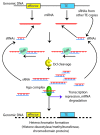Can silencing of transposons contribute to variation in effector gene expression in Phytophthora infestans?
- PMID: 22934246
- PMCID: PMC3429519
- DOI: 10.4161/mge.20265
Can silencing of transposons contribute to variation in effector gene expression in Phytophthora infestans?
Abstract
Transposable elements are ubiquitous residents in eukaryotic genomes. Often considered to be genomic parasites, they can lead to dramatic changes in genome organization, gene expression, and gene evolution. The oomycete plant pathogen Phytophthora infestans has evolved a genome organization where core biology genes are predominantly located in genome regions that have relatively few resident transposons. In contrast, disease effector-encoding genes are most frequently located in rapidly evolving genomic regions that are rich in transposons. P. infestans, as a eukaryote, likely uses RNA silencing to minimize the activity of transposons. We have shown that fusion of a short interspersed element (SINE) to an effector gene in P. infestans leads to the silencing of both the introduced fusion and endogenous homologous sequences. This is also likely to occur naturally in the genome of P. infestans, as transcriptional inactivation of effectors is known to occur, and over half of the translocated "RXLR class" of effectors are located within 2 kb of transposon sequences in the P. infestans genome. In this commentary, we review the diverse transposon inventory of P. infestans, its control by RNA silencing, and consequences for expression modulation of nearby effector genes in this economically important plant pathogen.
Figures



Comment on
- Vetukuri RR, Tian Z, Avrova AO, Savenkov EI, Dixelius C, Whisson SC. Silencing of the PiAvr3a effector-encoding gene from Phytophthora infestans by transcriptional fusion to a short interspersed element. Fungal Biol. 2011;115:1225–33. doi: 10.1016/j.funbio.2011.08.007.
Similar articles
-
Phenotypic diversification by gene silencing in Phytophthora plant pathogens.Commun Integr Biol. 2013 Nov 1;6(6):e25890. doi: 10.4161/cib.25890. Epub 2013 Jul 26. Commun Integr Biol. 2013. PMID: 24563702 Free PMC article. Review.
-
Silencing of the PiAvr3a effector-encoding gene from Phytophthora infestans by transcriptional fusion to a short interspersed element.Fungal Biol. 2011 Dec;115(12):1225-33. doi: 10.1016/j.funbio.2011.08.007. Epub 2011 Sep 23. Fungal Biol. 2011. PMID: 22115441
-
Evidence for small RNAs homologous to effector-encoding genes and transposable elements in the oomycete Phytophthora infestans.PLoS One. 2012;7(12):e51399. doi: 10.1371/journal.pone.0051399. Epub 2012 Dec 14. PLoS One. 2012. PMID: 23272103 Free PMC article.
-
Elicitin genes in Phytophthora infestans are clustered and interspersed with various transposon-like elements.Mol Genet Genomics. 2005 Mar;273(1):20-32. doi: 10.1007/s00438-005-1114-0. Epub 2005 Feb 9. Mol Genet Genomics. 2005. PMID: 15702346
-
Understanding and exploiting late blight resistance in the age of effectors.Annu Rev Phytopathol. 2011;49:507-31. doi: 10.1146/annurev-phyto-072910-095326. Annu Rev Phytopathol. 2011. PMID: 21663437 Review.
Cited by
-
Biotechnological approaches in management of oomycetes diseases.3 Biotech. 2021 Jun;11(6):274. doi: 10.1007/s13205-021-02810-y. Epub 2021 May 18. 3 Biotech. 2021. PMID: 34040923 Free PMC article. Review.
-
Phenotypic diversification by gene silencing in Phytophthora plant pathogens.Commun Integr Biol. 2013 Nov 1;6(6):e25890. doi: 10.4161/cib.25890. Epub 2013 Jul 26. Commun Integr Biol. 2013. PMID: 24563702 Free PMC article. Review.
-
Dominance of Mating Type A1 and Indication of Epigenetic Effects During Early Stages of Mating in Phytophthora infestans.Front Microbiol. 2020 Feb 21;11:252. doi: 10.3389/fmicb.2020.00252. eCollection 2020. Front Microbiol. 2020. PMID: 32153537 Free PMC article.
-
Navigating Host Immunity and Concurrent Ozone Stress: Strain-Resolved Metagenomics Reveals Maintenance of Intraspecific Diversity and Genetic Variation in Xanthomonas on Pepper.Evol Appl. 2025 Jan 14;18(1):e70069. doi: 10.1111/eva.70069. eCollection 2025 Jan. Evol Appl. 2025. PMID: 39816160 Free PMC article.
-
Pathogen small RNAs: a new class of effectors for pathogen attacks.Mol Plant Pathol. 2015 Apr;16(3):219-23. doi: 10.1111/mpp.12233. Mol Plant Pathol. 2015. PMID: 25764211 Free PMC article. Review. No abstract available.
References
-
- Whisson SC, Avrova AO, Boevink PC, Armstrong MR, Seman ZA, Hein I, et al. Exploiting knowledge of pathogen effectors to enhance late blight resistance in potato. Potato Res. 2011;54:325–40. doi: 10.1007/s11540-011-9197-y. - DOI
LinkOut - more resources
Full Text Sources
